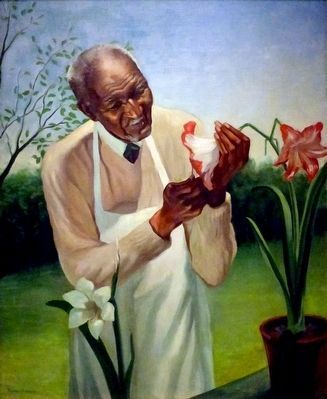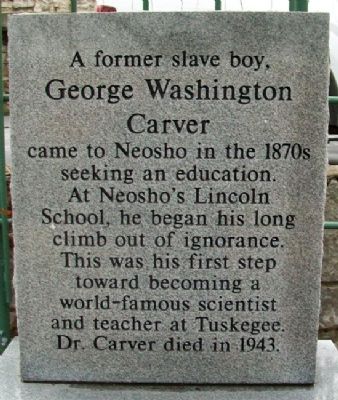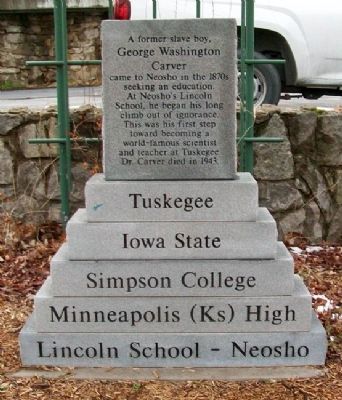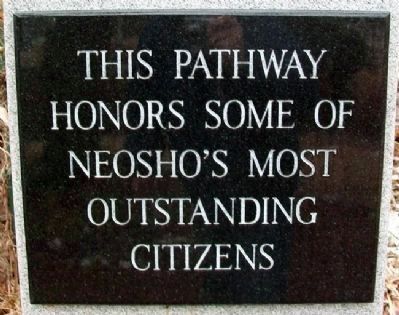Neosho in Newton County, Missouri — The American Midwest (Upper Plains)
George Washington Carver
A former slave boy, George Washington Carver came to Neosho in the 1870s seeking an education. At Neosho’s Lincoln School, he began his long climb out of ignorance. This was his first step toward becoming a world-famous scientist and teacher at Tuskegee. Dr. Carver died in 1943.
Lincoln School – Neosho • Minneapolis (KS) High • Simpson College • Iowa State • Tuskegee
Topics and series. This historical marker is listed in these topic lists: African Americans • Agriculture • Education • Science & Medicine. In addition, it is included in the George Washington Carver, and the Historically Black Colleges and Universities series lists. A significant historical year for this entry is 1943.
Location. 36° 52.209′ N, 94° 22.331′ W. Marker is in Neosho, Missouri, in Newton County. Marker is on Spring Street near Spring Hill Street, on the right when traveling west. Marker is north across Spring Street from Big Spring Park. Touch for map. Marker is at or near this postal address: 308 West Spring Street, Neosho MO 64850, United States of America. Touch for directions.
Other nearby markers. At least 8 other markers are within walking distance of this marker. Thomas Hart Benton (here, next to this marker); Herman Jaeger (here, next to this marker); James S. Scott (here, next to this marker); Founding of Neosho (within shouting distance of this marker); Rocketdyne (about 300 feet away, measured in a direct line); Abbott Cave (about 400 feet away); Heaton Building (approx. 0.2 miles away); Downtown Neosho Historic District (approx. 0.2 miles away). Touch for a list and map of all markers in Neosho.
Also see . . .
1. George Washington Carver. Wikipedia entry:
“Carver developed techniques to improve soils depleted by repeated plantings of cotton. Together with other agricultural experts, he urged farmers to restore nitrogen to their soils by practicing systematic crop rotation: alternating cotton crops with plantings of sweet potatoes or legumes (such as peanuts, soybeans and cowpeas). These crops both restored nitrogen to the soil and were good for human consumption. Following the crop rotation practice resulted in improved cotton yields and gave farmers alternative cash crops. To train farmers to successfully rotate and cultivate the new crops, Carver developed an agricultural extension program for Alabama that was similar to the one at Iowa State. To encourage better nutrition in the South, he widely distributed recipes using the alternative crops.” (Submitted on February 2, 2019.)
2. George Washington Carver. Historic Missourians website entry (Submitted on June 1, 2011, by William Fischer, Jr. of Scranton, Pennsylvania.)
3. George Washington Carver National Monument. National Park Service website entry (Submitted on June 1, 2011, by William Fischer, Jr. of Scranton, Pennsylvania.)
4. Tuskegee Institute National Historic Site. Nation Park service website entry (Submitted on June 1, 2011, by William Fischer, Jr. of Scranton, Pennsylvania.)

Oil by Betsy Graves Reyneau, 1942
5. George Washington Carver
This 1942 portrait of George Washington Carver by Betsy Graves Reyneau hangs in the National Portrait Gallery in Washington DC.
“Born Diamond Grove (formerly Diamond), Missouri. Born into slavery, George Washington Carver overcame the obstacles of slender means and racial discrimination to seek an education. He believed that "when you can do the common things of life in an uncommon way, you will command the attention of the world." These words, coupled with his lifelong goal to help poor black farmers trapped in sharecropping and dependency on cotton as a crop, pervaded his work at Alabama's Tuskegee Institute, where he was director of agricultural teaching and research for nearly forty years. Carver's laboratory investigations led to the discovery of more than 450 new commercial products-ranging from margarine to library paste-that could be extracted from previously untapped sources such as the peanut and sweet potato. He demonstrated for southern farmers the wisdom of diversifying crops, instead of relying mainly on the soil-exhausting crop of cotton.” — National Portrait Gallery
“Born Diamond Grove (formerly Diamond), Missouri. Born into slavery, George Washington Carver overcame the obstacles of slender means and racial discrimination to seek an education. He believed that "when you can do the common things of life in an uncommon way, you will command the attention of the world." These words, coupled with his lifelong goal to help poor black farmers trapped in sharecropping and dependency on cotton as a crop, pervaded his work at Alabama's Tuskegee Institute, where he was director of agricultural teaching and research for nearly forty years. Carver's laboratory investigations led to the discovery of more than 450 new commercial products-ranging from margarine to library paste-that could be extracted from previously untapped sources such as the peanut and sweet potato. He demonstrated for southern farmers the wisdom of diversifying crops, instead of relying mainly on the soil-exhausting crop of cotton.” — National Portrait Gallery
Credits. This page was last revised on March 22, 2022. It was originally submitted on June 1, 2011, by William Fischer, Jr. of Scranton, Pennsylvania. This page has been viewed 1,554 times since then and 69 times this year. It was the Marker of the Week February 3, 2019. Photos: 1, 2, 3, 4. submitted on June 1, 2011, by William Fischer, Jr. of Scranton, Pennsylvania. 5. submitted on August 12, 2015, by Allen C. Browne of Silver Spring, Maryland.



